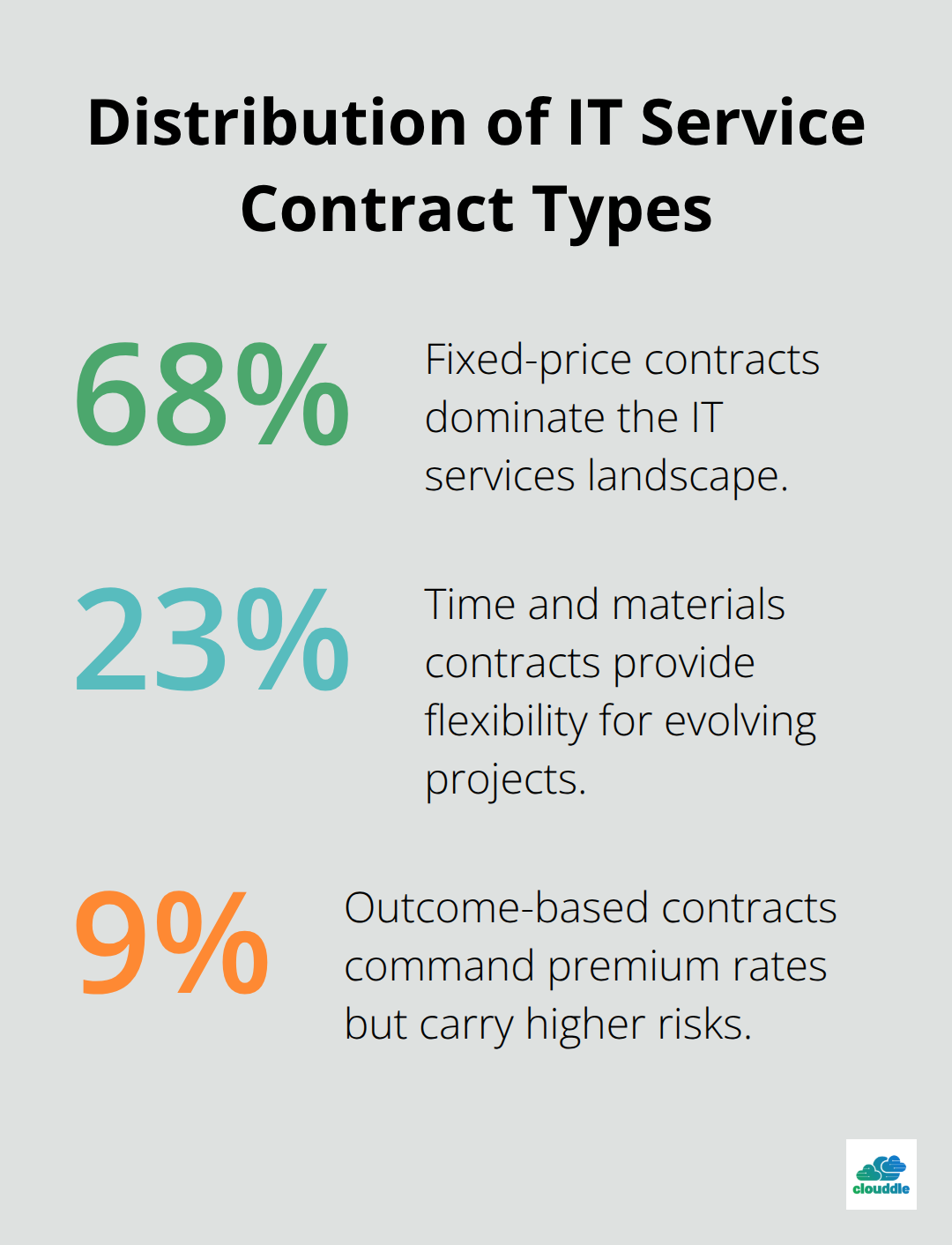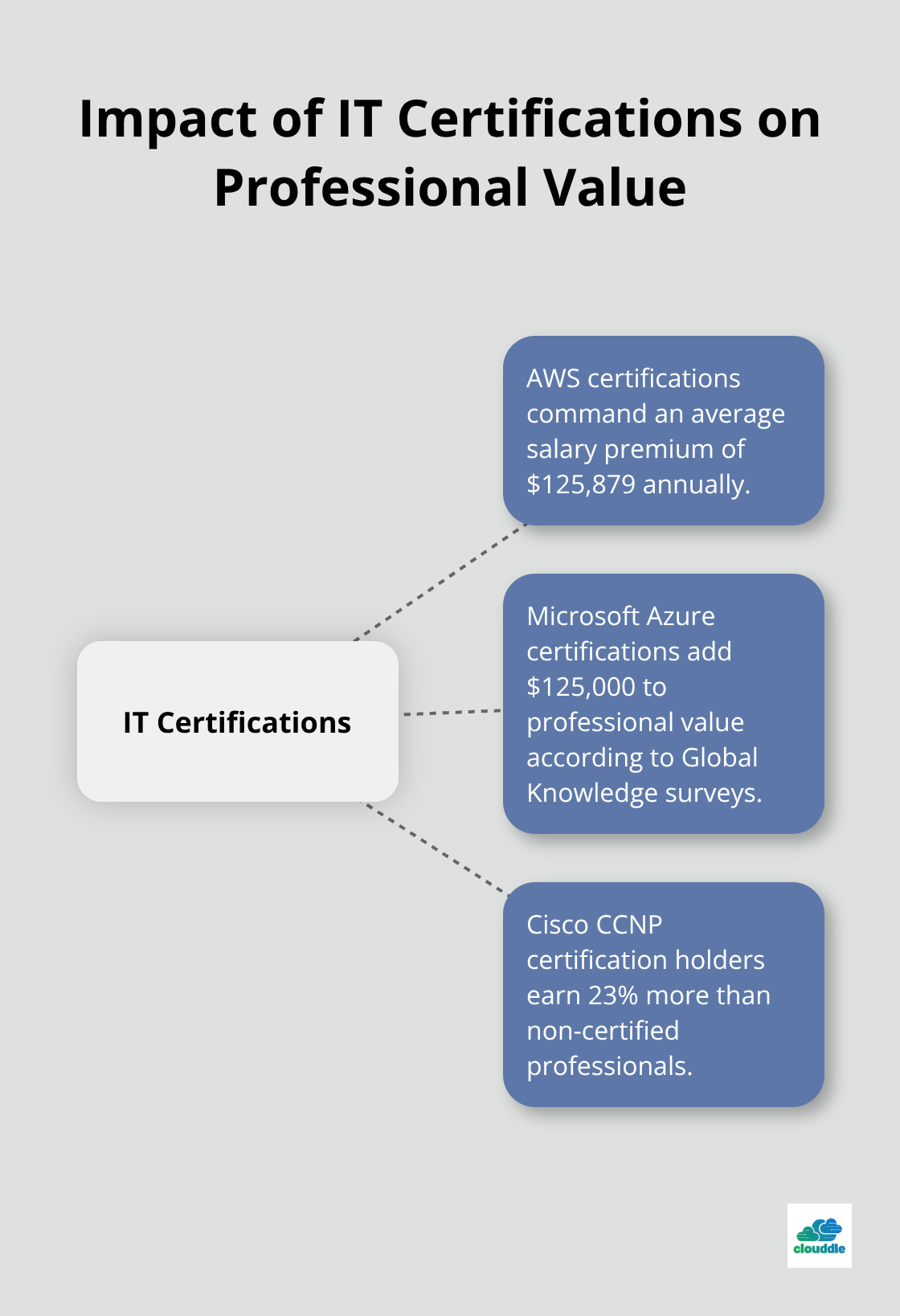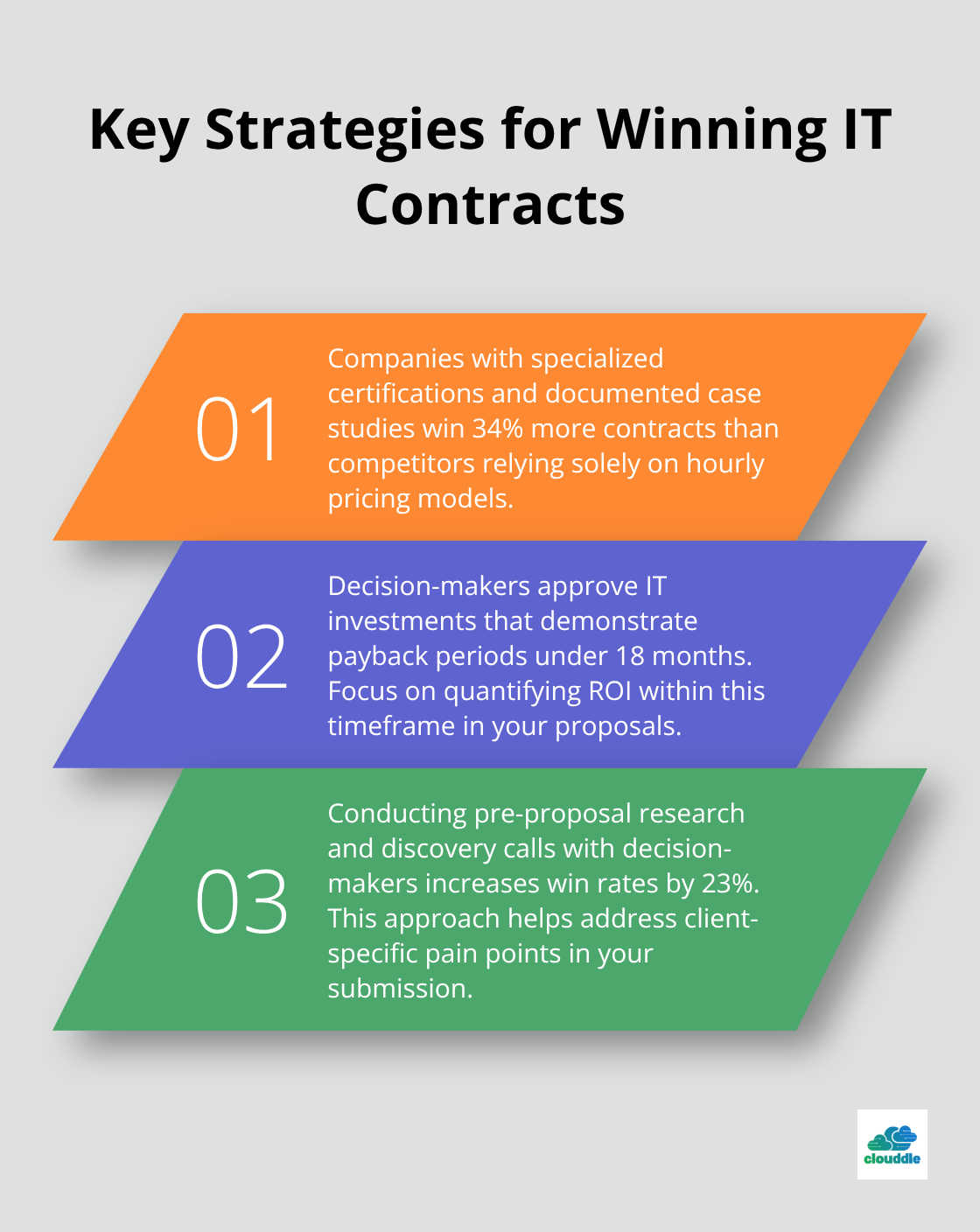The IT services market reached $1.3 trillion in 2024, with businesses increasingly outsourcing complex technology projects. Competition for IT security contracts has intensified as companies prioritize cybersecurity investments.
We at Clouddle understand the challenges IT service providers face when pursuing lucrative contracts. This guide provides proven strategies to position your business ahead of competitors and win more deals.
Which IT Contracts Generate the Most Revenue
Fixed-price contracts dominate the IT services landscape, accounting for 68% of all agreements according to Deloitte research. These contracts offer predictable revenue streams but require precise cost estimation. Time and materials contracts represent 23% of the market and provide flexibility for projects with evolving requirements. The remaining 9% consists of outcome-based contracts, which command premium rates but carry higher performance risks.

Service Models That Drive Profits
Managed services contracts provide financial motivation for proactive IT management, unlike break-fix arrangements where providers only get paid when clients have problems. Companies that offer comprehensive IT management see average contract values of $15,000 monthly compared to $3,500 for reactive support services. This shift toward proactive management creates stable, recurring revenue streams that clients value highly.
Cloud migration projects average $85,000 per engagement, while cybersecurity implementations range from $25,000 to $150,000 (depending on company size). Network infrastructure upgrades consistently deliver contracts worth $50,000 to $200,000. Healthcare and financial services sectors pay premium rates, often 25-30% above standard rates for specialized compliance requirements.
High-Growth Market Opportunities
Remote work infrastructure represents the fastest-growing segment, expanding 34% annually since 2022. Artificial intelligence integration projects command average fees of $120,000 per implementation. Small businesses with 50-200 employees offer the sweet spot for IT service providers, requiring sophisticated solutions without enterprise-level complexity.
Government contracts through SAM.gov provide stable, long-term revenue but demand extensive documentation and compliance processes. Manufacturing companies increasingly outsource IT operations, creating opportunities worth $75,000 annually per mid-sized facility.
Client Segments That Pay Premium Rates
Healthcare organizations require HIPAA compliance and specialized security measures, which justify higher rates. Financial institutions need robust cybersecurity frameworks and regulatory compliance support. Educational institutions seek comprehensive network solutions that support both administrative and learning environments.
These high-value segments expect providers to understand their unique challenges and regulatory requirements. Success in these markets requires specialized expertise and proven track records in sector-specific implementations.
What Expertise Do You Need to Win IT Contracts
Technical certifications separate serious IT providers from amateur competitors. AWS certifications command average salary premiums of $125,879 annually, while Microsoft Azure certifications add $125,000 to professional value according to Global Knowledge surveys. Cisco certifications remain industry gold standards, with CCNP holders earning 23% more than non-certified professionals.
CompTIA Security+ certification becomes mandatory for government contracts, while advanced certifications like CISSP open doors to enterprise cybersecurity projects worth $200,000 annually. These credentials demonstrate technical competence and commitment to professional development that clients expect from serious providers.

Portfolio Development That Converts Prospects
Case studies with quantifiable results drive contract wins more effectively than generic materials. Document specific metrics like 99.9% uptime achievements, 40% cost reductions, or 60-day implementation timelines. Healthcare IT implementations that demonstrate HIPAA compliance attract premium clients, while financial services case studies that showcase regulatory adherence command higher rates.
Manufacturing clients respond to productivity improvements and downtime reduction statistics. Video testimonials from C-level executives carry more weight than written references, with prospects who spend 3x more time on video content according to Wyzowl research. Real client outcomes provide the proof points that decision-makers need to justify their investment.
Competitive Pricing Strategies
Value-based pricing outperforms hourly rates in competitive situations. Research shows IT service providers who use project-based pricing win 34% more contracts than hourly competitors. Calculate total cost of ownership for clients rather than just implementation costs (this approach demonstrates long-term thinking).
Include maintenance, security updates, and support in comprehensive packages. Government contracts require detailed cost breakdowns with profit margins built into labor rates. Private sector clients accept higher margins for specialized expertise, particularly in cybersecurity and compliance areas. Competitive analysis of local market rates prevents underbids that damage profitability and client relationships.
The next step involves translating this expertise into compelling proposals that win contracts against established competitors.
How Do You Write Proposals That Win IT Contracts
Proposals that win IT contracts require precision that most competitors ignore. Good bid writing involves identifying customer needs, meeting requirements, and being responsive to their goals, not just the stated requirements. Your executive summary must address the client’s specific pain points within the first 150 words, as procurement teams spend just 90 seconds on initial proposal screening according to Aberdeen Group studies. Technical sections should present solutions with the client’s terminology from their RFP, not generic industry jargon that signals copy-paste approaches.
ROI Calculations That Close Deals
Quantified value propositions separate winners from mediocre submissions. Calculate specific cost savings, productivity gains, and risk reductions for each client scenario. A manufacturing client saves $47,000 annually through 99.9% uptime guarantees, while healthcare organizations reduce compliance costs by $23,000 per year with automated security monitoring (these figures come from actual client implementations). Present three-year total cost of ownership comparisons that include hidden costs competitors overlook. Decision-makers approve IT investments that demonstrate payback periods under 18 months, so front-load immediate benefits in your financial analysis.
Pre-Proposal Research That Wins Contracts
Discovery calls with IT directors, CFOs, and end users before RFP submission deadlines determine contract outcomes more than technical capabilities. Document their priorities, budget constraints, and decision timelines during these conversations. Reference these insights throughout your proposal to demonstrate understanding beyond the written requirements. This approach increases win rates by 23% according to proposal management research.
Follow-Up Strategies That Convert
Contact key stakeholders within 48 hours of proposal submission with personalized messages. Address specific concerns raised during discovery calls and provide additional technical details that support your solution. Schedule brief check-in calls to answer questions and maintain visibility throughout the evaluation process (most competitors submit proposals and wait passively for responses).
Final Thoughts
IT security contracts demand strategic positioning that extends beyond technical capabilities. Companies that combine specialized certifications with documented case studies win 34% more contracts than competitors who rely solely on hourly pricing models. Value-based proposals that quantify ROI within 18-month payback periods consistently outperform generic submissions during procurement evaluations.
The biggest mistake IT providers make involves submitting proposals without conducting pre-RFP discovery calls with decision-makers. This passive approach ignores client-specific pain points that separate winning bids from rejected ones. Underpricing services to win contracts damages long-term profitability and client relationships (another critical error that undermines business growth).

Growing your IT business requires focus on high-value market segments like healthcare, financial services, and manufacturing. These sectors pay premium rates for specialized compliance expertise and proven implementation track records. We at Clouddle help businesses navigate these opportunities through our managed IT services, demonstrating how Network as a Service models create recurring revenue while delivering measurable client value.


